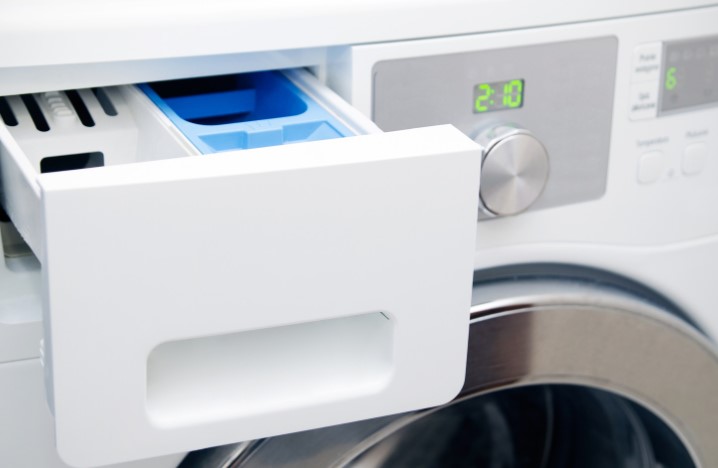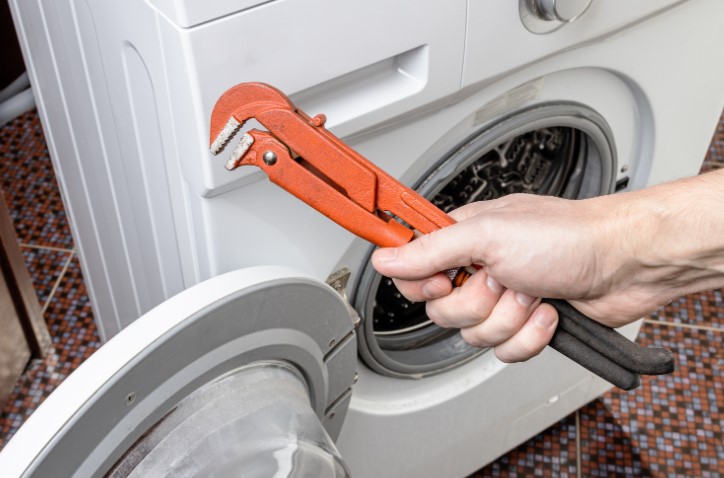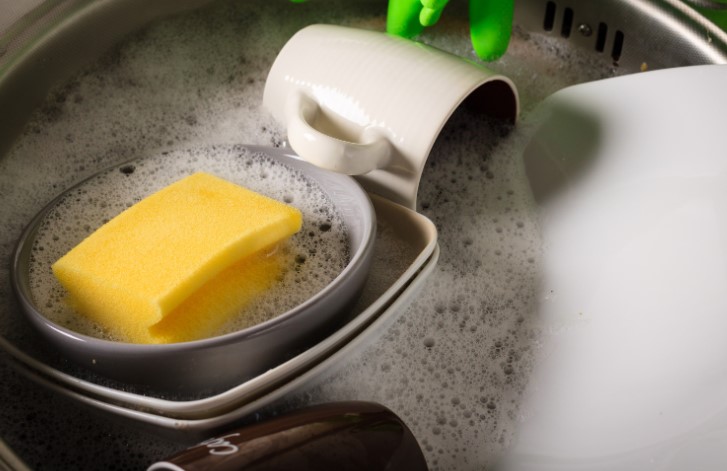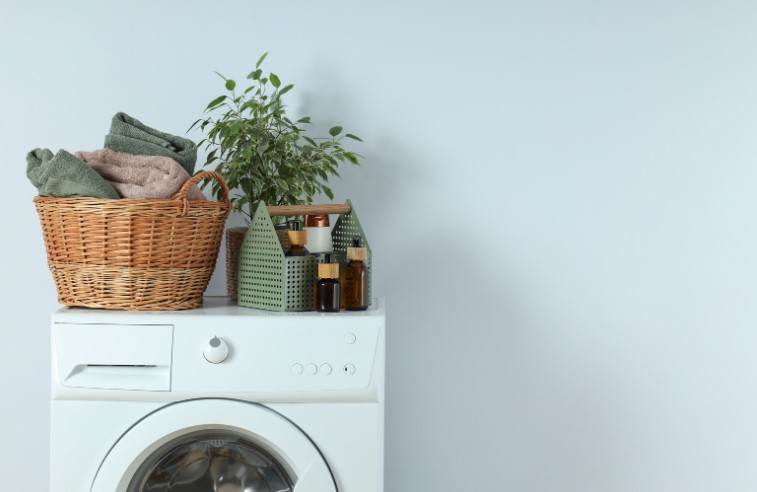- Why Does the Washing Machine Drawer Get Dirty?
- How to Remove the Detergent Drawer from a Washing Machine?
- How to Clean Washing Machine Drawer? – Step-by-Step Guide
- How to Clean a Washing Machine Drawer with Bicarbonate of Soda?
- How to Clean a Washing Machine Drawer with White Vinegar?
- How to Clean a Washing Machine Drawer Using Lemon Juice?
- How to Clean a Washing Machine Drawer Using Bleach?
- How to Clean a Washing Machine Drawer with Dish Soap?
- How to Clean a Washing Machine Drawer with Hydrogen Peroxide?
- My Recommendation: What’s the Best Cleaning Method?
- Conclusion
Keeping the washing machine detergent drawer clean is essential for maintaining hygiene and preventing unpleasant odours. Over time, detergent residue, fabric softener buildup, and moisture can lead to mould growth, mildew, and clogged compartments.
In this guide, I will walk you through several effective home remedies on how to clean washing machine drawer.
From natural solutions like vinegar and bicarbonate of soda to stronger methods like bleach, you will find the best way to keep your washing machine drawer spotless.
Why Does the Washing Machine Drawer Get Dirty?
What are the Common Causes of Dirt and Mould Build-up?
- Detergent residue accumulation – Powdered detergents tend to leave more buildup than liquid detergents.
- Moisture retention – A damp environment encourages mould and mildew growth.
- Fabric softener deposits – These can clog compartments and create a sticky film inside the drawer.
- Poor ventilation – Lack of airflow inside the drawer compartment allows bacteria and bad odours to develop.
How to Remove the Detergent Drawer from a Washing Machine?
What is the Step-by-Step Guide to Remove the Drawer Safely?
- Pull the drawer out as far as possible.
- Locate and press the release clip, usually in the middle or side of the drawer.
- Gently slide the drawer out completely without forcing it.
- Remove any separate compartments such as the fabric softener dispenser.
- Check the user manual if you are unsure about how to remove your washing machine drawer.
If the drawer is stuck due to detergent buildup, gently wiggle it while pulling to loosen it.

How to Clean Washing Machine Drawer? – Step-by-Step Guide
Step 1: Pre-Soak the Drawer to Loosen Residue
- Fill a bowl with warm water and vinegar in a 1:1 ratio.
- Soak the drawer for 15-30 minutes to break down detergent and softener buildup.
Step 2: Scrub the Drawer Thoroughly
- Use a toothbrush or scrubbing brush for hard-to-reach areas.
- Focus on removing mould spots, soap residue, and fabric softener buildup.
Step 3: Clean the Inside of the Drawer Slot
- Dampen a cloth with vinegar solution and wipe the slot inside the washing machine.
- Use cotton swabs to clean tight corners where dirt and mould collect.
Step 4: Rinse and Dry the Drawer Completely
- Rinse the drawer under warm running water to remove any remaining debris.
- Let it air dry fully before reinserting it into the machine.
Never put the drawer back while it is still damp, as this can encourage mould growth.
How to Clean a Washing Machine Drawer with Bicarbonate of Soda?
Why Use Bicarbonate of Soda?
- Removes stubborn stains without the use of harsh chemicals.
- Neutralises bad odours and prevents future buildup.
- Acts as a mild abrasive for scrubbing detergent residue.
What are the Steps for Cleaning with Bicarbonate of Soda?
- Make a cleaning paste by mixing 2 tablespoons of bicarbonate of soda with a little water.
- Apply the paste inside the drawer and scrub using a toothbrush.
- Soak the drawer in warm water and bicarbonate of soda for 15-20 minutes.
- Rinse thoroughly and dry before reinserting into the washing machine.

How to Clean a Washing Machine Drawer with White Vinegar?
Why Is White Vinegar Effective for Cleaning?
- Breaks down detergent residue and limescale.
- Kills bacteria and removes bad odours.
What are the Steps for Cleaning with White Vinegar?
- Soak the drawer in warm water and vinegar (1:1 ratio) for 30 minutes.
- Scrub with a brush to remove remaining dirt and mould.
- Wipe the inside of the drawer slot with a cloth soaked in vinegar solution.
- Rinse and air dry before reinserting.
To keep your machine fresh, add half a cup of vinegar to the detergent drawer and run an empty hot wash cycle once a month.
How to Clean a Washing Machine Drawer Using Lemon Juice?
What are the Benefits of Lemon Juice for Cleaning?
- Natural antibacterial and antifungal properties.
- Removes limescale and hard water stains.
- Leaves a fresh citrus scent.
What are the Steps to Clean with Lemon Juice?
- Squeeze fresh lemon juice into a cup of warm water.
- Dip a cloth or brush in the solution and scrub the drawer.
- Soak for 15 minutes for extra freshness.
- Rinse and dry thoroughly before reinserting.
For an extra powerful natural cleaner, mix lemon juice with bicarbonate of soda.

How to Clean a Washing Machine Drawer Using Bleach?
When to Use Bleach for Cleaning?
- Only when deep mould buildup is present.
- Use caution, as bleach is a strong chemical.
- Always wear gloves and ventilate the area.
What are the Steps to Clean with Bleach?
- Dilute one part bleach with four parts water in a bucket.
- Soak the drawer in the solution for 10 minutes.
- Scrub with a brush to remove mould.
- Rinse thoroughly to remove all traces of bleach.
Never mix bleach with vinegar, as it creates toxic fumes.
How to Clean a Washing Machine Drawer with Dish Soap?
When to Use Dish Soap for Cleaning?
- If you don’t have vinegar or bicarbonate of soda.
- If your drawer has light detergent buildup but no mould.
What are the Steps for Cleaning with Dish Soap?
- Fill a basin with warm soapy water.
- Soak the detergent drawer for 15-20 minutes.
- Scrub with a soft brush or sponge.
- Rinse thoroughly and dry before putting it back.
Choose eco-friendly dish soap to avoid chemical residue.

How to Clean a Washing Machine Drawer with Hydrogen Peroxide?
Why Use Hydrogen Peroxide?
- Disinfects and kills mould effectively.
- Removes stubborn stains without damaging plastic.
- Eco-friendly alternative to bleach.
What are the Steps for Cleaning with Hydrogen Peroxide?
- Apply hydrogen peroxide directly to the mouldy areas.
- Let it sit for about 10 to 15 minutes to break down stains.
- Scrub with an old toothbrush.
- Rinse with warm water and dry completely.
Mix hydrogen peroxide with baking soda to create a thick cleaning paste for tough stains.
My Recommendation: What’s the Best Cleaning Method?
After testing different cleaning methods, the best and most effective way to clean a washing machine drawer is:
- Soak the drawer in white vinegar and warm water for 30 minutes.
- Scrub with bicarbonate of soda paste for deep cleaning.
- Wipe the drawer slot with vinegar solution to remove hidden dirt.
- Dry completely before reinserting.
This method is natural, safe, and highly effective, as vinegar dissolves detergent buildup while bicarbonate of soda scrubs away stains and neutralises odours.

Conclusion
Regular cleaning of your washing machine drawer is essential to prevent mould, odours, and detergent buildup. Using natural home remedies like vinegar, bicarbonate of soda, and lemon juice provides an effective, safe, and eco-friendly cleaning solution.
Follow these tips on how to clean washing machine drawer and with consistent cleaning routine, your washing machine will stay fresh, hygienic, and perform at its best for years to come.
What are the FAQs – Answering Common Questions
1. Can I put my washing machine drawer in the dishwasher?
Some plastic drawers are dishwasher-safe, but check the user manual first.
2. Why does my washing machine drawer smell bad?
The smell is usually caused by mould, detergent residue, or stagnant water. Cleaning with vinegar and bicarbonate of soda will help eliminate odours.
3. How can I prevent detergent buildup in the drawer?
- Use liquid detergent instead of powder.
- Wipe the drawer dry after each wash.
- Run a hot wash with vinegar once a month.
4. How do I stop mould from coming back?
- Leave the drawer open after every wash.
- Use a tea tree oil spray to prevent mould regrowth.
- Clean once a month to keep it fresh.


0 Comments